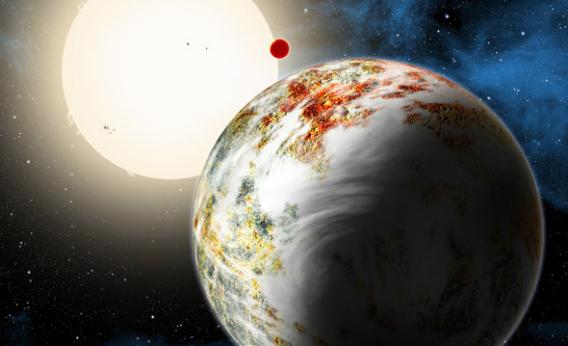Astronomers Find a New Type of Exoplanet: “Mega Earth”

Oh, that tricksy nature. Just when we think we won’t be surprised by what we find, we find, well, a surprise. In this case, astronomers have discovered that a nearby star has a kind of planet never before seen: a “mega Earth,” a rocky planet far larger and more massive than our own.
The planet is Kepler-10c, about 550 light years from Earth, and it was actually first discovered back in 2011. It was found by the Kepler space telescope, which uses the transit method to look for planets orbiting other stars. If we happen to see a planet’s orbit edge-on, it passes between the star and us every orbit, blocking a wee bit of starlight. The planet’s orbital period (its year) can be directly measured (you just wait to see how long it takes between dips), and its size can be found as well—the bigger the planet, the more light it blocks.
Kepler 10-c, it turns out, has a diameter about 2.35 times the Earth’s. That’s big enough that it should have a thick atmosphere, making it more like a mini-Neptune than Earth. If that were the case, then you’d expect its density to be low, since gas giants like that, which are after all mostly gas, have a low density.
To get the density you need to find the mass. You can’t do that with the transit method, so the mass was unknown until recently. The astronomers used the HARPS-North detector to look at the star, breaking its light up into a spectrum. As the planet orbits the star in a wide circle, the star makes a smaller one, which means that sometimes it’s moving toward the Earth, and sometimes away. By measuring the Doppler shift of that signal, the mass of the planet can be found.
And that’s where they got a surprise. The planet is 17.2 times the mass of Earth. That’s a lot, far more than you’d expect for a mini-Neptune that size. That puts its density around 7.5 gram/cubic centimeter, which is astonishingly high; the Earth is about 5.5, while a typical gas giant is around just 1. A density that high means the planet must be rocky, much like Earth is.
That’s very cool. I’ll note the planet isn’t really Earth-like. Its surface gravity would be over three times Earth’s (I’d weigh more than 500 pounds on Kepler-10c), for starters. Also, Kepler-10, the parent star, is much like the Sun, but the planet orbits much closer to it than Earth does to the Sun. The surface temperature on the planet may be around 200°C (400° F)—even higher if it has an atmosphere. You could bake chocolate chip cookies on the ground. But they’d be very flat.
Incidentally, there’s another planet in this system: Kepler-10b, which is three times the mass and 1.5 times the size of Earth. That gives it a density much like Earth’s, so it too must be rocky. In fact, it was the first confirmed rocky planet found, but it orbits the star only a couple of million kilometers out, and has a surface temperature of more than 2,000°C! So while it’s rocky, it’s most likely molten rock. Not a fun place to visit, I’d wager.
I have to say, while this discovery is a surprise, I wouldn’t call it a shock. What I mean is, while we weren’t expecting it, one thing we’ve found looking at the nearly 2,000 confirmed planets discovered so far is that exoplanets are weird. Well, maybe our own solar system is weird and we just think it’s normal because hey, it’s home. But ironically, finding the unexpected is just what you expect when exploring a new frontier. A new category of planet is something we may find happens quite a bit as we dig deeper.
The first exoplanet was found just 20 years ago, so we’re still pretty new at all this; we’re just getting started with the surprises. There’s lots more weirdness out there in the Universe just waiting for us to uncover it.


























